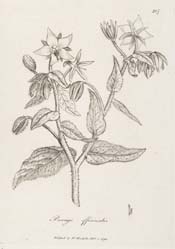

|
Borage
(Borago officinalis)
|
Boneset
Botanical: Eupatorium perfoliatum (LINN.)
Family: N.O. Compositae
---Synonym---Thoroughwort.
---Part Used---Herb.
---Habitat---Thoroughwort or Boneset is a very common and familiar plant in low meadows and damp ground in North America, extending from Nova Scotia to Florida.
Boneset was a favourite medicine of the North American Indians, who called it by a name that is equivalent to 'Ague-weed,' and it has always been a popular remedy in the United States, probably no plant in American domestic practice having more extensive and frequent use; it is also in use to some extent in regular practice, being official in the United States Pharmacopceia, though it is not included in the British Pharmacopoeia.
---Constituents---All parts of the plant are active, but the herb only is official, the leaves and tops being gathered after flowering has commenced. They contain a volatile oil, some tannic acid, and Eupatorin, a bitter glucosidal principle, also resin, gum and sugar. The virtues of the plant are yielded both to water and alcohol.
---Description---Boneset is a perennial herb, with an erect stout, cylindrical hairy stem, 2 to 4 feet high, branched at the top. The leaves are large, opposite, united at the base, lance-shaped, 4 to 8 inches long (the lower ones being the largest), tapering to a sharp point, the edges finely toothed, the veins prominent, the blades rough above, downy and resinous and dotted beneath. The leaves serve to distinguish the species at the first glance - they may be considered either as perforated by the stem, perfoliate (hence the specific name), or as consisting of two opposite leaves joined at the base, the botanical term for which is connate. The flower-heads are terminal and numerous, large and slightly convex, with from ten to twenty white florets, having a bristly pappus, the hairs of which are arranged in a single row. The odour of the plant is slightly aromatic, the taste astringent and strongly bitter. This species shows considerable variety in size, hairiness, form of leaves and inflorescence. It flowers from July to September.
---Medicinal Action and Uses---Stimulant, febrifuge and laxative. It acts slowly and persistently, and its greatest power is manifested upon the stomach, liver, bowels and uterus.
It is regarded as a mild tonic in moderate doses, and is also diaphoretic, more especially when taken as a warm infusion, in which form it is used in attacks of muscular rheumatism and general cold. In large doses it is emetic and purgative.
Many of the earlier works allude to this species as a diuretic, and therefore of use in dropsy, but this is an error, this property being possessed by Eupatorium purpureum, the purple-flowered Boneset, or Gravel Root.
It has been much esteemed as a popular febrifuge, especially in intermittent fever, and has been employed, though less successfully, in typhoid and yellow fevers. It is largely used by the negroes of the Southern United States as a remedy in all cases of fever, as well as for its tonic effects. As a mild tonic it is useful in dyspepsia and general debility, and particularly serviceable in the indigestion of old people. The infusion of 1 OZ of the dried herb to 1 pint of boiling water may be taken in wineglassful doses, hot or cold: for colds and to produce perspiration, it is given hot; as a tonic, cold.
As a remedy in catarrh, more especially in influenza, it has been extensively used and with the best effects, given in doses of a wineglassful, warm every half hour, the patient remaining in bed the whole time; after four or five doses, profuse perspiration is caused and relief is obtained. It is stated that the popular name Boneset is derived from the great value of this remedy in the treatment of a species of influenza which had much prevailed in the United States, and which from the pain attending it was commonly called Break-Bone Fever.
This species of Eupatorium has also been employed in cutaneous diseases, and in the expulsion of tapeworm.
---Preparations---Powdered herb. Dose 12 to 20 grains.
Fluid extract, 1/2 to 1 drachm.
Eupatorin. Dose, 1 to 3 grains.
See:
GRAVEL ROOT
EUPATORIUM
(HEMP) AGRIMONY
[Top]
Common Name Index
A MODERN HERBAL Home Page
Purchase this Herb from Botanical.com
Bear in mind "A Modern Herbal" was written with the conventional wisdom of the early 1900's. This should be taken into account as some of the information may now be considered inaccurate, or not in accordance with modern medicine.
© Copyright Protected 1995-2004 botanical.com

|



